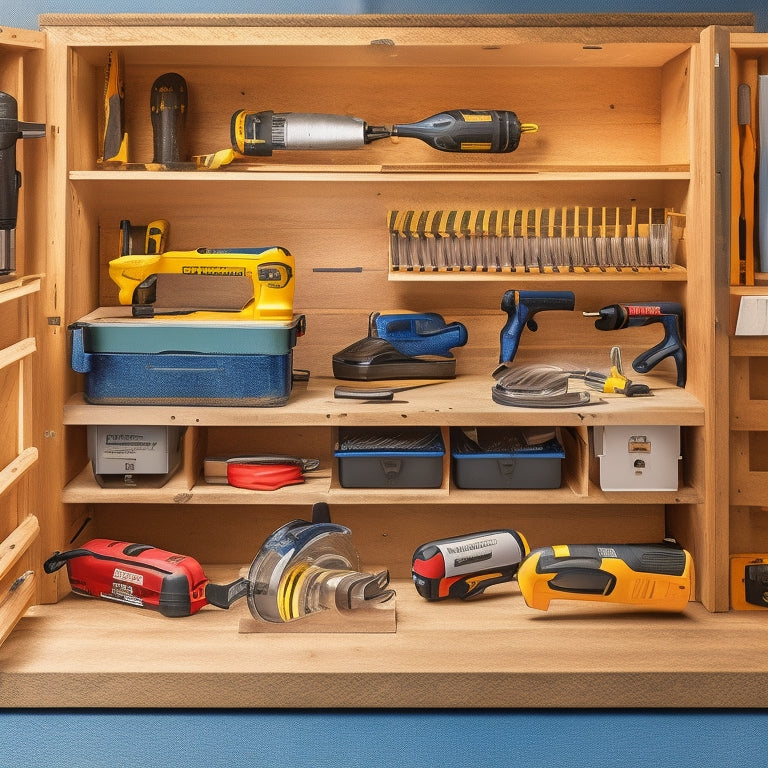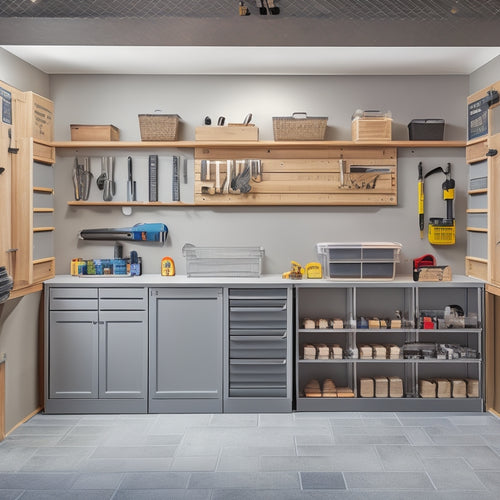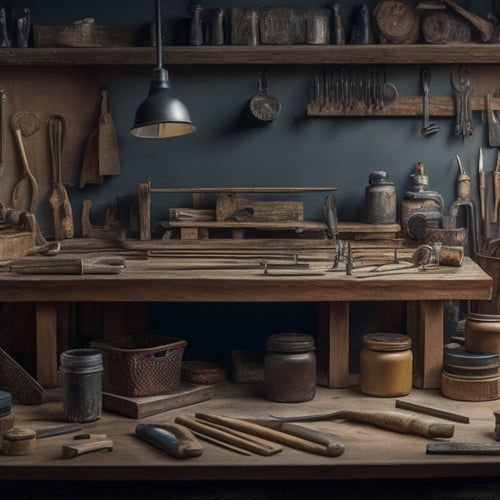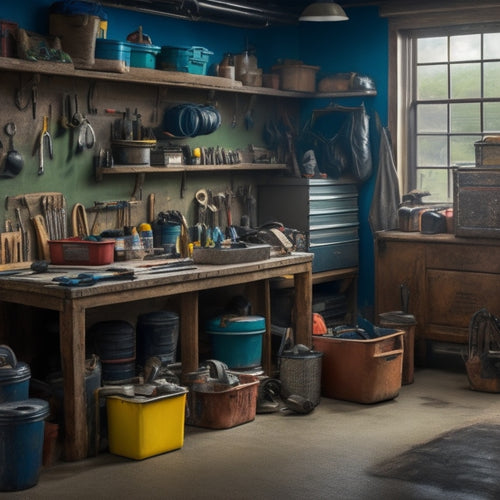
Power Tool Organizers to Maximize Tool Box Space
Share
You're likely wasting precious time searching for misplaced tools in a cluttered toolbox, reducing your productivity and increasing the risk of accidents and damage to expensive equipment. To maximize your tool box space, consider investing in portable, stationary, or hybrid power tool organizers that cater to your specific needs. Analyze your tool inventory, available space, and usage frequency to determine the best organizer type. By choosing the right organizer, you'll enhance efficiency, reduce time spent searching, and improve safety. Now, investigate the various options and strategies outlined here to change your toolbox into a well-organized haven that improves your workflow.
Key Takeaways
- Assess your tool box needs by cataloging tools, measuring space, and prioritizing storage for frequently used tools.
- Choose the right organizer by considering tool type, storage capacity, accessibility, durability, and organizational features.
- Maximize vertical storage space by utilizing unused space, using vertical shelving, and installing pegboard systems and overhead storage solutions.
- Customize your tool box layout by grouping frequent-use tools, categorizing by function or type, and using adjustable compartments and dividers.
- Consider pre-made power tool organizers or DIY solutions, such as pegboard installation, drawer dividers, and wall-mounted racks, to enhance tool box space.
Types of Power Tool Organizers
Three primary types of power tool organizers cater to different needs and preferences: portable, stationary, and hybrid organizers.
You'll find that each type offers unique benefits and features to help you maximize your tool box space.
Portable organizers, such as tool chests, tool racks, and portable boxes, are ideal for professionals on-the-go or those with limited storage space.
They're compact, easy to transport, and often feature stacking bins and foam inserts to keep your tools organized and protected.
Stationary organizers, like shelf organizers, drawer dividers, and pegboard systems, are perfect for workshops or garages with dedicated tool storage areas.
They provide ample space to store and display your tools, and can be customized with magnetic strips to keep frequently used items within easy reach.
Hybrid organizers combine the best of both worlds, offering flexibility and versatility.
They often feature wall mounts, allowing you to easily move them around your workspace as needed.
Benefits of Tool Box Organization
Efficient tool box organization can make a significant difference in your work productivity and overall job satisfaction. When your tools are organized, you'll experience an efficiency enhancement that allows you to complete tasks quickly and effectively. This, in turn, leads to time savings, as you'll no longer waste minutes searching for misplaced tools.
A well-organized tool box also promotes safety by reducing the risk of accidents caused by tripping over clutter or misplacing sharp objects. With a tidy workspace, you'll feel more in control and focused on the task at hand. Inventory management becomes easier, as you can quickly identify which tools need to be restocked or replaced.
An organized tool box also provides an accessibility improvement, allowing you to grab the right tool at the right moment. Moreover, this level of organization is cost-effective, as you'll avoid buying duplicate tools and reduce the risk of damage or loss.
Ultimately, a well-organized tool box guarantees project readiness, giving you the confidence to tackle any task that comes your way.
Assessing Your Tool Box Needs
As you've experienced the benefits of efficient tool box organization, you're now ready to take the next step: evaluating your tool box needs.
This vital step helps you identify the ideal power tool organizer for your specific requirements. To do this effectively, you'll need to take stock of your tool inventory and assess your available space.
Tool Box Needs Assessment Checklist:
-
Tool Inventory: Take an inventory of all your power tools, accessories, and consumables. This will help you determine the types of tools you need to store and the frequency of use.
-
Space Optimization: Measure your tool box's dimensions and identify any obstacles or constraints that may impact your storage needs. Consider the size and shape of your tools, as well as any specific storage requirements, such as separate compartments for batteries or chargers.
-
Frequency of Use: Identify the tools you use most frequently and prioritize their storage. This will guarantee that your most-used tools are easily accessible and conveniently stored.
Choosing the Right Organizer
You've assessed your tool box needs, now it's time to choose the right organizer.
To do this, you'll need to contemplate what type of organizer best fits your tools and work style, as well as plan the storage capacity you require.
Tool Box Assessment Needed
Take inventory of your tool collection to determine the type of power tool organizer you need. This evaluation is essential in maximizing your tool box space and ensuring you have a well-organized and efficient workspace.
Begin by categorizing your tools into groups, such as drills, saws, and sanders. Next, measure the dimensions of your tool box or storage space to determine the maximum size of your organizer.
Consider the following key factors when evaluating your tool box:
-
Tool inventory: Make a list of the power tools you own and their sizes to determine the type of compartments you need.
-
Space efficiency: Identify the most space-consuming tools and plan your organizer accordingly to optimize storage.
-
Accessibility: Think about the tools you use most frequently and prioritize easy access to them.
Organizer Type Selection
Get set to find the perfect match for your power tool collection by delving into the world of organizer types. You'll uncover a range of options designed to maximize your tool box space and keep your tools within easy reach.
Universal organizers provide flexibility, accommodating various tool sizes and types. Portable solutions, such as tool bags and foldable storage, are ideal for on-the-go professionals. For a more permanent setup, consider wall-mounted racks or pegboard systems, which offer customizable storage and easy access.
If you're working with limited space, drawer dividers and magnetic strips can help optimize your existing storage. Modular units and tool chests provide an all-encompassing storage solution, often featuring separate compartments and trays.
When choosing an organizer, consider factors like durability, ease of use, and adaptability to your specific tool collection. By selecting the right organizer type, you'll create a safe and efficient workspace that enhances productivity.
Storage Capacity Planning
Evaluating your power tool collection is essential in determining the ideal storage capacity for your organizer. You need to take stock of the number and types of tools you have, as well as their sizes and weights. This will help you decide on the right size and configuration of your organizer.
To guarantee maximum space optimization, consider the following:
-
Tool inventory: Make a list of all your power tools, including drills, saws, sanders, and other accessories. Note their dimensions and weights to determine the space required for each item.
-
Tool usage frequency: Identify the tools you use most frequently and prioritize their storage locations for easy access.
-
Organizer customization: Consider an organizer with adjustable compartments or dividers to accommodate tools of varying sizes and shapes.
DIY Power Tool Organizer Ideas
By dedicating a few hours on the weekend, you can create a customized power tool organizer that suits your specific needs and workspace. Start by evaluating your tool collection and identifying the most frequently used items. This will help you determine the layout and design of your organizer.
For a pegboard, install shelf brackets and hang pegboard hooks to maximize vertical storage. Tool chests with drawer dividers can keep smaller items organized, while wall-mounted racks can hold larger equipment. Consider adding tool trays with magnetic strips to store metal tools and parts.
Toolbox liners can protect your tools from rust and corrosion, and storage bins can keep consumables like drill bits and sandpaper within reach.
To optimize your cabinet space, use cabinet organizers with adjustable shelves and compartments. This will enable you to store power tools, accessories, and materials in a logical and accessible manner.
Pre-Made Power Tool Organizers
You'll find that pre-made power tool organizers offer two primary advantages: tool holder systems that keep your tools within easy reach, and customizable storage solutions that adapt to your specific power tool collection.
These systems typically feature adjustable dividers, removable bins, and hooks to accommodate a wide range of power tools and accessories.
Tool Holder Systems
Many power tool enthusiasts and professionals opt for pre-made tool holder systems, which offer a convenient and efficient way to organize their equipment.
These systems typically consist of a series of power tool racks, compartments, and dividers specifically designed to hold various tool holder types. By using a pre-made system, you can guarantee that your tools are safely stored, easily accessible, and protected from damage.
Some benefits of pre-made tool holder systems include:
-
Efficient use of space: These systems are designed to maximize storage capacity, allowing you to fit more tools in a smaller area.
-
Customization options: Many pre-made systems offer customization options, such as adjustable dividers and removable compartments, to fit your specific tool collection.
-
Improved safety: By keeping your tools organized and out of the way, you can reduce the risk of accidents and injuries in the workspace.
Customizable Storage Solutions
Customizable storage solutions, also known as pre-made power tool organizers, elevate tool holder systems to the next level by offering even greater flexibility and adaptability.
You can tailor these solutions to fit your specific tool collection and storage needs. Modular shelving, for instance, allows you to create a customized storage layout that maximizes your tool box space. Adjustable compartments enable you to accommodate tools of varying sizes, while portable racks provide easy transport and storage.
You can also employ wall-mounted storage and pegboard solutions to keep frequently used tools within easy reach. Drawer dividers help keep your tools organized and prevent clutter, and tool labels guarantee you can quickly identify what's inside each compartment.
Magnetic strips can be applied to store small metal tools, and clear containers provide a clear view of their contents. By incorporating these customizable storage solutions into your tool box, you'll be able to work more efficiently and safely, with all your tools organized and within reach.
Maximizing Vertical Storage Space
About 75% of a typical workshop or garage remains unused, with most of the available space going to waste above the workbench or shelves. You can reclaim this lost space by maximizing your vertical storage.
To start, consider installing vertical shelving or wall mounted racks to store less frequently used tools or equipment. These will help keep your workbench clear and create a sense of openness in the room.
Additionally, you can employ:
-
Pegboard systems to hang tools and accessories, keeping them organized and within easy reach.
-
Overhead storage solutions, such as stackable bins or magnetic strips, to store items like nuts, bolts, or small parts.
-
Sliding drawers or tool caddies to store items like hand tools, drill bits, or other small items.
Customizing Your Tool Box Layout
Toolbox real estate is important, and a well-planned layout is essential to maximizing efficiency and productivity. As you customize your tool box layout, consider your toolbox aesthetics and user preferences. Think about the tools you use most frequently and group them together in an easily accessible area. This will save you time and energy in the long run.
Next, categorize your tools by function or type, and assign a specific section of your tool box to each category. For example, you might've a section for drilling tools, another for cutting tools, and so on. This will help you quickly locate the tool you need and prevent clutter from building up.
Don't forget to leave some space between each section for easy retrieval and to prevent tools from getting tangled or damaged. Consider adding dividers or compartments to keep small items organized and within reach.
Frequently Asked Questions
Can I Use a Power Tool Organizer in a Portable Toolbox?
You can definitely use a power tool organizer in a portable toolbox, ensuring toolbox compatibility, as long as you choose an organizer designed for portable storage, allowing you to safely store and access your tools on-the-go.
How Do I Organize Cordless Tool Batteries and Chargers?
Did you know that 60% of tool-related accidents occur due to poor battery storage? You'll prevent hazards and streamline your workflow by using battery storage solutions, such as dividers or cases, and implementing charger management tips, like labeling and categorizing chargers by tool type.
Are Power Tool Organizers Compatible With All Toolbox Brands?
You'll find that most power tool organizers are designed to be versatile, but it's essential to check toolbox compatibility before buying. Look for organizers made from durable materials like heavy-duty plastic or metal that can withstand your toolbox's specific dimensions and weight capacity.
Can I Attach a Power Tool Organizer to a Pegboard?
As you're arranging your workspace, coincidentally, you're realizing the importance of pegboard benefits, like increased visibility and accessibility. Yes, you can attach a power tool organizer to a pegboard, following tool organization tips, such as measuring carefully and using sturdy hooks for a secure fit.
Do Power Tool Organizers Come With a Warranty or Guarantee?
You'll find that many manufacturers offer warranty options, ensuring their products' durability; they're confident in their craftsmanship, and you'll have peace of mind knowing you're protected in case something goes wrong, allowing you to focus on your projects with confidence.
Conclusion
You've now got the ultimate power tool organizer system in place, and it's like a well-oiled machine - every tool has its designated spot, and you can find what you need in a snap. With your tool box altered, you'll be more efficient, productive, and ready to tackle any project that comes your way. Your newly organized space will be the envy of all your DIY friends, and you'll be the expert of your domain, working with precision and ease.
Related Posts
-

Essential Steps for Garage Storage System Design
You're about to change your cluttered garage into an organized haven by following a structured approach to garage sto...
-

Top 5 Small Tool Organizers for Your Workshop
You're looking to optimize your workshop's efficiency with high-quality small tool organizers. Compact storage soluti...
-

Best Cheap Tool Boxes for Budget-Conscious Buyers
You need a reliable tool box that gets the job done without breaking the bank. Look for durable materials, rust-resis...


